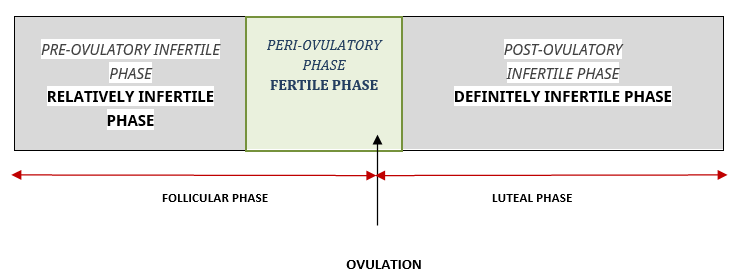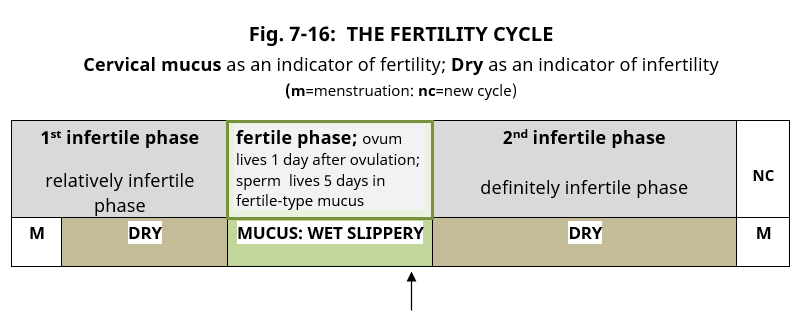What is the Fertility Cycle?
The fertility cycle is the menstrual cycle viewed from the perspective of when in the cycle the woman is infertile or when she is potentially fertile. Compare Fig 7-12, the Menstrual Cycle with with Fig 7-13, the Fertility Cycle, and also Fig 7-15.

Fig. 7-12: The menstrual cycle is divided into two phases by ovulation (the release of the ovum)
(a) the follicular phase when the ovum is maturing before ovulation and
(b) the luteal phase after ovulation.

Fig. 7-13: The Fertility Cycle has 3 phases, a Fertile phase after the 1st infertile phase & before the 2nd infertile phase.

Fig. 7-14: The 1st infertile phase is the pre-ovulatory infertile phase, or the ‘relatively infertile phase’. The Fertile Phase is called the peri-ovulatory phase and it includes the time of ovulation, the life-span of the ovum (24 hours),1 and the five days or so leading up to ovulation when pregnancy can occur, as sperm can survive for up to 5 days in oestrogenic fertile-type mucus;
The 2nd infertile phase is the phase after ovulation and is called the post-ovulatory infertile phase or the definitely infertile phase as the ovum is dead and no other ovulation will occur in that cycle. (Fig. 7-14).
How long do the ovum and sperm live?
The ovum lives for 24 hours. The sperm can survive for up to 5 days in oestrogenic fertile-type mucus.
Q. Are the phases of the fertility cycle the same as those of the menstrual cycle? ;
Answer: The phases of the menstrual cycle and fertility cycle are not the same, see Fig. 7-15
Fig.7-15: Comparison of the Fertility Cycle phases with those of the Menstrual Cycle

Fig. 7-15: The follicular and luteal phases of the menstrual cycle do not correspond exactly with the phases of the fertility cycle. This is because the fertile phase in the fertility cycle is longer than the actual ovulation event. There are two reasons for this; (i) the fertile phase comprises the life-span of sperm in fertile-type mucus before ovulation (5 days), and the life-span of the ovum (24 hours)1 after ovulation. (ii) The exact moment when ovulation occurs cannot be pin-pointed by the fertility indicators. The fertile phase therefore includes the 5 or 6 days of the follicular phase leading up to ovulation, and the first day of the luteal phase after ovulation.
When is the fertile phase in the cycle? (see Fig. 7-16)
In the ‘symptothermal double-check method’ of natural family planning the fertile phase begins with the first sign of cervical mucus at the vulva, cross-checked with the ‘calendar rule’ whichever comes first, and it ends when there is a sustained rise in the basal body temperature (BBT) cross-checked with the cervical mucus symptom whichever comes last. The fertile phase includes the 5 or 6 days of the follicular phase leading up to ovulation, and the first day of the luteal phase after ovulation.
How long does the fertile phase last?
The LIMITS of the fertile phase are defined by the RULES of the NFP Method used by the couple and they must learn these rules from a qualified NFP teacher. ʽThe potential fertile phase of a couple is the time from the first act of intercourse which may lead to pregnancy to the demise of the ovum’.2 According to Freundl 4 there are only 6 – 9 days of the menstrual cycle on which intercourse may result in pregnancy. The fertile phase normally occupies not more than one-third of the cycle.3

Fig. 7-16: The Cervical Mucus as an indicator of fertility; Dry as an indicator of Infertility :
The diagram shows the three phases of the fertility cycle. The relatively infertile phase includes the days of menstruation and the ‘dry’ days that follow the period before the onset of the mucus symptom. The fertile phase includes the ovulation event and is heralded by the build-up of oestrogenic (fertile-type) mucus which indicates a rising oestrogen level from the developing follicle in the ovary and is a sign of potential fertility. The definitely infertile phase after ovulation shows a return to the sensation of dryness at the vulva due to the drying-up action of progesterone from the corpus luteum on the cervical crypts by stimulating the secretion of gestogenic mucus. The definitely infertile phase is so-called, as the woman is definitely infertile in this phase as the ovum is dead and no further ovulation will occur in that cycle, and the gestogenic mucus occludes the cervical canal and prevents sperm entry into the uterus.
Does ovulation occur on the same day in every cycle; is it always in mid-cycle?
The day of ovulation is not fixed in the middle of the cycle, but it varies from one cycle to another. It usually occurs about 14 days before the next period because the luteal phase after ovulation has a relatively constant length of 14 days, (range 10-16 days). [If the cycle length is 30 days, ovulation probably occurred on Day 16 of the cycle (30 minus 14 = 16), and if the cycle length is 25 days, ovulation would probably have occurred on Day 11 of the cycle, (25 minus 14 = 11)].
Does ovulation occur just once in the cycle?
The answer is YES. If two ova mature in any particular cycle, as in the case of twins, both ova will be released within the same 24 hour period.
References
- Wilcox AJ, Weinberg CR, Baird DD; ‘Timing of sexual intercourse in relation to ovulation – effects on the probability of conception, survival of the pregnancy, and sex of the baby’; N Engl J Med 1995; 333;1517-21.
- World Health Organization; ‘Temporal relationship between indices of the fertile period’,1983 page 1; Fertil & Steril; 39; 647-655. (Dr Anna Flynn was one of the investigators on the WHO task force for this study).
- Klaus, Hanna; ‘Natural family planning – Is it scientific? Is it effective?’ page 1; Newman Lecture Series 1; May 21, 2000. (online).
- Freundl G et al; “Estimated maximum failure rates of cycle monitors using conception probabilities in the menstrual cycle”; Human Reproduction, (2003), vol 18, no12, p 2628-2633.


